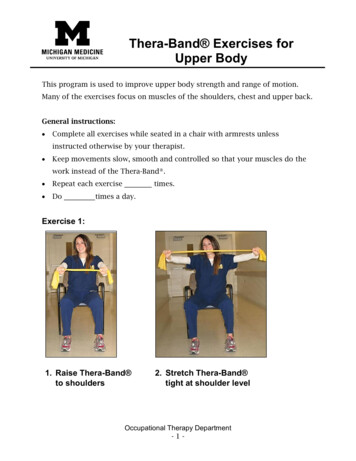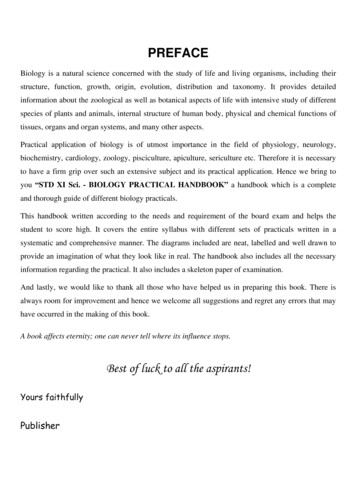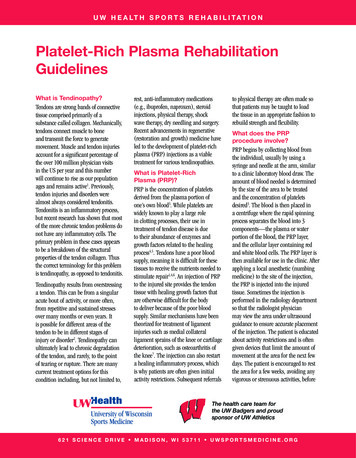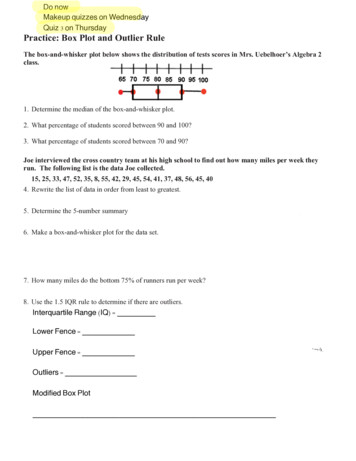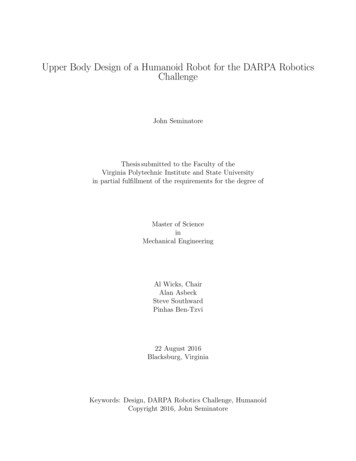
Transcription
Upper Body Design of a Humanoid Robot for the DARPA RoboticsChallengeJohn SeminatoreThesis submitted to the Faculty of theVirginia Polytechnic Institute and State Universityin partial fulfillment of the requirements for the degree ofMaster of ScienceinMechanical EngineeringAl Wicks, ChairAlan AsbeckSteve SouthwardPinhas Ben-Tzvi22 August 2016Blacksburg, VirginiaKeywords: Design, DARPA Robotics Challenge, HumanoidCopyright 2016, John Seminatore
Upper Body Design of a Humanoid Robot for the DARPA RoboticsChallengeJohn SeminatoreAcademic AbstractHumanoid robots have captured the imagination of authors and researchers for years. Development of the bipedal walking necessary for humanoid robots began in earnest in the late60’s with research in Europe and Japan. The the unique challenges of a bipedal locomotionled to initial robots keeping power, computation, and perception systems off-board whiledeveloping the actuators and algorithms to enable locomotion. As technology has improvedhumanoid and exoskeleton systems have finally incorporated all the various subsytems tobuild a full independent system. Many of the groups building these platforms have developed them based on knowledge acquired through decades of prior development. For groupsdeveloping new humanoid systems little guidance on the pitfalls and challenges of humanoiddesign exist.Virginia Tech’s robot ESCHER, developed for the DARPA Robotics Challenge (DRC), isthe 4th generation full sized humanoid developed at the University. This paper attempts toquantify the design trades and techniques used to predict performance of ESCHER and howthese trades specifically affected the design of the upper body. The development of ESCHERbecame necessary when it became obvious that the original design assumptions behind theprevious robot THOR left it incapable of completing the DRC course and the necessaryupgrades would require an almost complete redesign. Using the methods described in thispaper ESCHER was designed manufactured and began initial testing within 10 months. Oneand a half months later ESCHER became the first humanoid to walk the 60 m course at theDRC.The methods described in this paper provide guidance on the decision making process behindthe various subsystems on ESCHER. In addition the methodology of developing a dynamicsimulation to predict performance before development of the platform helped provide designrequirements that ensured the performance of the system. By setting design requirements.ESCHER met or exceeded the goals of the team and remains a valuable development platformthat can provide utility well beyond the DRC.
Upper Body Design of a Humanoid Robot for the DARPA RoboticsChallengeJohn SeminatorePublic AbstractLong a product of science fiction, humanoid robots have been in development by researcherssince the late 60’s but still haven’t reached their promised potential. The DARPA RoboticsChallenge (DRC) was an inducement prize contest held in 2013 and 2015 to help acceleratethe use of robotic systems for disaster response scenarios. Team VALOR Virginia Tech’sentry into the competition was required to build a completely new humanoid in 10 months,resulting in the Electric Series Compliant Humanoid for Emergency Response or ESCHER.The rapid development of ESCHER was made possible by system engineering and a analysisto ensure ESCHER could meet all the competition goals. At The DRC ESCHER becamethe first humanoid to walk the 60m course.Humanoid research labs have used intuition and knowledge gained through decades of experience to design their systems. This paper discusses techniques used to design the upperbody of ESCHER as well as modeling and simulation to predict performance when designinga humanoid. By using trade analysis and modeling researcher’s new to the field can designto a predicted performance point with confidence in a chiving accurate results.
AcknowledgmentsA project the size and scope of ESCHER can not possibly be accomplished by one person,and I would not be here (finally) with out the support of a wide variety of people bothacademically and personally. When the first Grand challenge was announced I could onlydream of being involved in something so world changing. To get the opportunity to competewith the best roboticists in the world and earn there respect was an amazing feeling. Thankyou to everyone who made this possible.First I need to thank my family who supported this crazy Idea of mine to give up a promisingcareer to go back to school and completely shift gears. I know they were worried, but I hopeI’ve made them proud and calmed some of their concerns. Second I would like to thank myadvisors. Dr. Wicks stepped up to get me through the last part of my thesis and encouragedme to foray into the world of teaching. That opportunity is something I will never forgetand something I aim to continue no matter where my career takes me. Dr. Asbeck youhelped remind me how amazing what we were doing really was, it’s easy to take for grantedsomething you see every day. Your enthusiasm and support won’t be forgotten. Dr. BenTzvi in my experiences most professors aren’t looking to add to their student load, for youto specifically ask to be added to my committee me and take the time out of your busyschedule means a lot. Dr. Southward your were hands down the best instructor I had duringmy time at VT. WIthout you I would not be able to say with confidence I am a controlsspecialist. That you would take time out of your vacation for me is more than I could haveasked for.Of course the members of TREC, previously known as RoMeLa are to numerous to call outin the space available, but without a doubt you all were the finest team I could have asked towork with. Even with the press we got I don’t think VT fully appreciated the talents we hadand how amazing the team was. The fact you all had the faith in my leadership to help meguide the DRC team was incredibly humbling, and I hope I made you guys proud. Not onlywere you guys amazing coworkers, but you were an amazing friends as well. I hope we havean opportunity to work together again in the future. I do need to mention a few people whospecifically helped with the data in this thesis. Dr. Mike Hopkins, Jacob Webb and ColemanKnabe, who helped generate the payload analysis data, Jason Ziglar who led the analysis ofcomputer requirements and perception systems and Jack Newton who helped determine ourpower requirements. Also thank you to Christian Rippe who was indispensable in the finiteiv
element analysis of the original chest design.Finally I’d like to thank all the people outside the lab who made me feel at home in Blacksburg. Thank you Ingrid, Chris, Tommy and Charlie for all the dinners concerts and eventsyou invited me to. It’s all to easy to get lost in work and the world of robots. You guysalways pulled me out and reminded me there was life on the outside.This work is supported by ONR through grant N00014-11-1-0074 and by DARPA throughgrant N65236-12- 1-1002.v
Contents1 Introduction11.1DARPA Robotics Challenge . . . . . . . . . . . . . . . . . . . . . . . . . . .11.2History of Humanoids. . . . . . . . . . . . . . . . . . . . . . . . . . . . . .21.3History of Inducement Prize . . . . . . . . . . . . . . . . . . . . . . . . . . .31.3.1DARPA . . . . . . . . . . . . . . . . . . . . . . . . . . . . . . . . . .4Chapter summaries . . . . . . . . . . . . . . . . . . . . . . . . . . . . . . . .81.42 Literature Review102.1Previous analysis . . . . . . . . . . . . . . . . . . . . . . . . . . . . . . . . .102.2Bipedal Walking . . . . . . . . . . . . . . . . . . . . . . . . . . . . . . . . .112.2.1Humanoids . . . . . . . . . . . . . . . . . . . . . . . . . . . . . . . .112.2.2Exoskeletons . . . . . . . . . . . . . . . . . . . . . . . . . . . . . . . .14Perception . . . . . . . . . . . . . . . . . . . . . . . . . . . . . . . . . . . . .152.3.1LIDAR Mount Types . . . . . . . . . . . . . . . . . . . . . . . . . . .16Power System . . . . . . . . . . . . . . . . . . . . . . . . . . . . . . . . . . .182.32.43 Design203.1Reevaluation of Requirements . . . . . . . . . . . . . . . . . . . . . . . . . .203.2Mechanical Deficiencies . . . . . . . . . . . . . . . . . . . . . . . . . . . . . .213.2.1Knee . . . . . . . . . . . . . . . . . . . . . . . . . . . . . . . . . . . .213.2.2Arms . . . . . . . . . . . . . . . . . . . . . . . . . . . . . . . . . . . .22Perception Analysis . . . . . . . . . . . . . . . . . . . . . . . . . . . . . . . .223.3vi
3.4Computational Analysis . . . . . . . . . . . . . . . . . . . . . . . . . . . . .233.5Electrical Analysis . . . . . . . . . . . . . . . . . . . . . . . . . . . . . . . .253.6Simulation . . . . . . . . . . . . . . . . . . . . . . . . . . . . . . . . . . . . .253.6.1Development of the Simulation model . . . . . . . . . . . . . . . . . .26Mass Budget . . . . . . . . . . . . . . . . . . . . . . . . . . . . . . . . . . .293.74 Capabilities304.1Overall Design . . . . . . . . . . . . . . . . . . . . . . . . . . . . . . . . . . .304.2Mechanical Design . . . . . . . . . . . . . . . . . . . . . . . . . . . . . . . .304.3Perception . . . . . . . . . . . . . . . . . . . . . . . . . . . . . . . . . . . . .334.4Electrical and Computer Systems . . . . . . . . . . . . . . . . . . . . . . . .334.5Maintenance . . . . . . . . . . . . . . . . . . . . . . . . . . . . . . . . . . . .345 Results365.1Overall performance . . . . . . . . . . . . . . . . . . . . . . . . . . . . . . .365.2Mechanical requirements . . . . . . . . . . . . . . . . . . . . . . . . . . . . .365.2.1Mass Budget . . . . . . . . . . . . . . . . . . . . . . . . . . . . . . .375.2.2Volume . . . . . . . . . . . . . . . . . . . . . . . . . . . . . . . . . .395.2.3Arms . . . . . . . . . . . . . . . . . . . . . . . . . . . . . . . . . . . .395.2.4Manufacturability . . . . . . . . . . . . . . . . . . . . . . . . . . . . .405.3Perception requirements . . . . . . . . . . . . . . . . . . . . . . . . . . . . .405.4Electrical Requirements . . . . . . . . . . . . . . . . . . . . . . . . . . . . .415.5Maintenance Requirements . . . . . . . . . . . . . . . . . . . . . . . . . . . .415.6DRC Performance . . . . . . . . . . . . . . . . . . . . . . . . . . . . . . . . .426 Future Work446.1Design Analysis . . . . . . . . . . . . . . . . . . . . . . . . . . . . . . . . . .446.2Knowledge Transfer . . . . . . . . . . . . . . . . . . . . . . . . . . . . . . . .446.3Covers . . . . . . . . . . . . . . . . . . . . . . . . . . . . . . . . . . . . . . .456.4Temperature Protection . . . . . . . . . . . . . . . . . . . . . . . . . . . . .45vii
6.5Falls and Fall Recovery . . . . . . . . . . . . . . . . . . . . . . . . . . . . . .466.6Knowledge base . . . . . . . . . . . . . . . . . . . . . . . . . . . . . . . . . .466.7Data Capture . . . . . . . . . . . . . . . . . . . . . . . . . . . . . . . . . . .47Bibliography48viii
List of Figures1.1Summary of the tasks for the DRC Trials(Source: DARPA) . . . . . . . . . .61.2Summary of the tasks for the DRC Finals (Source: DARPA) . . . . . . . . .72.1Two competitors from the DRC with extended arm lenths for improved manipulation workspace . . . . . . . . . . . . . . . . . . . . . . . . . . . . . . .132.2Coverage patterns of a yawing and pitching LIDAR mount . . . . . . . . . .172.3Comparison of view from monocular camera and rotating LIDAR . . . . . .172.4Battery Densities over Time[35] . . . . . . . . . . . . . . . . . . . . . . . . .183.1Comparison of knee torque required to maintain squatting pose of variousheights between simulation and hardware testing[48]. . . . . . . . . . . . . .283.2Sequence of steps simulated to generate predicted knee torques for ESCHER[48]. 283.3Simulated joint torques of a 60kg and 80 kg robot[48]. . . . . . . . . . . . . .294.1The computers for ESCHER highlighted in Red . . . . . . . . . . . . . . . .314.2Ultem support bushing . . . . . . . . . . . . . . . . . . . . . . . . . . . . . .324.3Custom mount for hard drive and miniPCI-E boards . . . . . . . . . . . . .344.4Access point for power and data connections for THOR shoulder servo . . .355.1Finite element analysis of original ESCHER upper body . . . . . . . . . . .385.2Timeline for day 1 of the DRC[50] . . . . . . . . . . . . . . . . . . . . . . . .425.3Timeline for day 2 of the DRC[50] . . . . . . . . . . . . . . . . . . . . . . . .43ix
List of Tables2.1Humanoid Size Comparison . . . . . . . . . . . . . . . . . . . . . . . . . . .122.2Exoskseleton Payload Comparison . . . . . . . . . . . . . . . . . . . . . . . .153.1Benchmark Data for On-board PC Evaluation . . . . . . . . . . . . . . . . .243.2ESCHER Sensor Requirements . . . . . . . . . . . . . . . . . . . . . . . . .254.1Comparison of THOR and ESCHER . . . . . . . . . . . . . . . . . . . . . .30x
Chapter 1Introduction1.1DARPA Robotics ChallengeThe 2005 DARPA Grand Challenge was the first time DARPA used an inducement challengeto attempt to jump start technological innovation. Thanks to the Grand Challengeautonomous vehicle systems have become commercially viable products in little more thana decade. The DARPA Robotics Challenge (DRC) was one of the most ambitious roboticscompletions ever held attempting to repeat the technological advancements created by theGrand Challenge. Robots have been used by the military for reconnaissance and bombclearing in increasing amounts since the turn of the century. However these robots have noautonomy and require significant operator training. Many of these systems are unable toclimb stairs or open doors and are almost impossible to operate in degraded communications.DARPA developed the competition to help advance robotic technology for use in disasterscenarios where dangerous situations would jeopardize the lives of rescue workers. Successin the DRC required advances in planning, perception, mobility and autonomy to allowgeneral purpose robots to respond to a wide variety of scenarios successfully. The disaster atFukushima Daiichi nuclear plant shortly before the announcement of the challenge furthershowed the limitations of the current robots in disaster situations.Virginia Tech’s Team VALOR was a TRACK A team, a team provided with funds todevelop a completely new platform from scratch for the purposes of the competition. Bythe DRC Finals Team VALOR had developed two new humanoid platforms, the TacticalHazardous Operations Robot (THOR) and the Electric Series Compliant Humanoid forEmergency Response (ESCHER). While THOR was a very advanced platform capable ofdynamic force controlled balancing with human like ranges of motion [1, 2] several earlydesign decisions limited its capabilities making it unsuited for the DRC finals. As a resultESCHER was developed with significantly more detailed analysis to ensure its capabilitiesmet the minimum threshold of the DRC Finals. This detailed analysis allowed for the rapid1
2redesign of over 90% of the systems on THOR producing a robot capable of far more thanthe DRC required, making it an excellent research platform for many years to come.1.2History of HumanoidsHumanoid Robots have long been an aspect of science fiction and popular culture, from FritzLang’s film Metropolis in 1927 to modern depictions of robots in films such as Star Wars.However it is only very recently that Humanoids have been able to approach the capabilitiesof their fictional counter parts. The bipedal for of a human presents inherent challenges instability since the robot only has two points of contact with the ground rather than threeor four. The complexity of actively balancing and Humanoids present a significant challengeto control since they carry significantly more mass in their upper body than in their legs.Why then research humanoids? Traditional robotic platforms take advantage of mechanicalsystems not available in nature such as wheels or fixed wings. Even many legged robots usea quad or hex legged configuration for additional stability. Much like with humans bipedalgaits can provide several advantages when interacting with the environment if locomotionand disturbance rejection can be made robust. A biped is a holonomic system with a smallerfootprint that a quadruped or heaxapod. The upright posture of humans allows us to reachhigher objects and see at longer distances compared to our ancestors. Similarly biped robotshave the potential to interact with a world designed by humans for humans with little changein infrastructure. Additionally a mechanical biped can be used to augment a disabled humanin the form of an exoskeleton allowing the to walk and move around the world with morefreedom than a wheelchair might allow.Again, the challenge is robust and reliable locomotion and manipulation. The inherentinstability in an upright bipedal posture makes falls potentially catastrophic for humans androbots. The problem of bipedal walking can be modeled as the control of an inverted pendulum, however the processing required for dynamic balancing has limited their performanceoutside lab settings. The labs that produce the most advanced humanoids today have utilizedesign techniques based on years of institutional knowledge with little documentation foroutside groups to learn from. For new groups attempting to enter into humanoids researchit is easy to make mistakes that limit performance and require expensive redesign or even awhole new design iteration.The first walking humanoid was ELEKTRO, demonstrated at the 1939 World’s Fair [3]. Heutilized a simple chain drives and flexible shafts in order to move his limbs. ELECTROhad no active control however and depended on his design to remain upright. Significantresearch began with the development of the concept of the Zero Moment Point (ZMP) byVukobratović. [4] The ZMP is defined as the location where the contact forces of the roboton the ground are opposite the inertia and momentum of the robots body. By keeping theZMP within a defined stability boundary dynamic stability of the robot could be maintained.Vukobratović and his team used this research to develop some of the earliest exoskeletons.
3Almost simultaneously with the development of ZMP control, mechanical work on bipedswas being performed at Waseda University in Japan. Dr. Ichiro Kato developed severalbipeds including the WL-3 and WAP-1 [5] generally considered the first true walking bipeds.These early efforts in bipedal locomotion began to show many of the challenges in size weightand power bipeds faced. All of the early bipeds utilized off-board computing and power forlocomotion and it wasn’t until WAP-3 in 1971 that full 3 dimensional walking was realized.These early attempts at bipeds, were purely lower bodies, the development of WABOT-1 iswidely considered the first full true full scale anthropomorphic robot. WABOT-1 began toshow many of the desired aspects of humanoid robots, with optical and auditory sensors, aswell as tactile sensors in the hands for gripping objects. These early attempts still lackedseveral of the traits desired in a humanoid robot, power tethers and off board computationensured that these robots would remain lab experiments.The Honda Humanoid Project started in 1986 was the first attempt to finally create a fullyindependent biped [6]. Honda’s goal with the project was to finally realize the primaryadvantage of humanoids, their flexibility. In theory a humanoid can utilize human tools andoperate in human environments without the need for a purpose built custom solution. Thefinal result ASIMO is one of the first fully realized bipeds to capture the public attention.ASIMO is the first biped capable of running, performing many demonstrations for the generalpublic. However, ASIMO is still operated primarily in controlled conditions. The DRCrepresented an opportunity to bring robots out of the lab and into the field for disasterresponse. Many in the humanoids community saw this as an opportunity to demonstratethe utility and flexibility inherent in the humanoid design. A humanoid can utilize thesame tools and resources as the disaster response teams minimizing the logistics footprint toaccommodate the robot. Additionally, humanoids would have an advantage operating in anenvironment designed around humans.1.3History of Inducement PrizeDARPA’s mission statement is to prevent technological surprise to the US and to causetechnological surprise to it’s enemies. Throughout history Inducement prizes have been usedto bolster the state of the art in technology. Since the turn of the century DARPA hasused inducement prizes to push the scientific community to advance key technologies. Oneof the most famous inducement prizes was the British Longitude Act of 1714 to create amethod to accurately track the longitude of sailing ships. Several costly shipwrecks causedby imprecise longitudinal measurement drove Parliament to offer a prizes of 10,000, 15,000and 20,000 for any system that could determine longitude to within 60, 40 and 30 nauticalmiles respectively. Though researchers at the time were aware that the Earth rotated 15 oflongitude per hour no reliable method of measurement existed at the time.There were two primary methods that rose to prominence, the lunar distance method and
4a mechanical chronometer. Early on Lunar distance methods were time intensive requiringup to 4 hours of calculations. Marine Chronometer’s weren’t even viable technologicallyuntil John Harrison created his H-4 marine Chronometer in 1761. Both these technologiesadvanced their fundamental sciences with the lunar methodology leading to the developmentof almanacs to cut calculation time down to 10-15 minutes. Chronometers were prohibitivelyexpensive at first, requiring complex bi-metallic springs to compensate for temperaturevariations, but by 1825 all British ships carried Chronometer’s. The ability to accuratelynavigate the seas the British were able to establish themselves as a naval power despite rivalssuch as France being already established colonial powers.The power of inducement prizes to stimulate technological and economic growth has led totheir utilization up until modern times. The Ansari X-Prize for example helped drive thecreation of commercial space companies. Originally winners were simply trying to bringpassengers to the edge of space. However, the success of Scaled Composites in 2004 helpedusher in an era of commercial spaceflight led by Space-X. The DARPA Grand Challengewas it’s first inducement prize challenge and it’s success in accelerating autonomous vehicletechnology led directly to the DRC.1.3.1DARPADARPA is a Department of Defense development agency in response to the Soviet launchof Sputnik in 19h57. DARPA’s mission is to prevent technological surprise to the US, andto create technological surprise to our enemies. The most famous development to arisefrom DARPA is the ARPANET, the first network to implement the TCP/IP protocol, thefoundation of the modern Internet. In more modern times, DARPA has pushed research inautomation and robotic systems to reduce US troops exposure to dangerous situations suchas IED’s. DARPA has had excellent results with inducement challenges, the most famous ofwhich was the Grand Challenge. The grand challenge helped accelerate autonomous vehiclesfrom science fiction to legitimate consumer products within 15 years. A similar desire to helpboost the utility of robots in disaster scenarios led to the DRC being announced in 2012.Grand ChallengeIn July of 2002 DARPA announced the first Grand Challenge, a 140 mi road race through thedesert of California and Nevada. A 1,000,000 would be awarded to the team who completedthe course the fastest within a 10hr limit. The goal was to help reduce the exposure of troopsto dangerous situations such as convoy duty in hostile territory. For example in 2003 therewere 531 casualties during resupply missions in Iraq, roughly 18% of the total casualties inthat year. [7, 8] An analysis of the state of the art at the time predicted half an hour ofautonomous driving and a total distance traveled of 2 miles [9]. Of the 15 qualifying teamsnone were able to complete the challenge. Carnegie Mellon’s Red Team achieved the best
5performance covering 7.4 miles before being hung up on a rock. [10] To the general publicthe Grand challenge seemed a failure, however the teams had beaten the expectations of theexperts.The second Grand Challenge was held 18 months later in October of 2005. This time of the 23finalists 5 vehicles completed the course, including a team created by a Louisiana Insurancecompany with no prior robotics experience [11]. 22 teams were able to beat the previousbest of 7.4 miles. The rapid pace of advancement helped prove the goals behind the GrandChallenge having pushed researchers to bring their project out of the labs and into the field.The Grand Challenge drove significant improvements in perception and localization as wellas sensor technologies for field use. The design of the course though physically challengingkept the vehicles in isolation. To truly develop the technologies for full autonomous drivingteams would need to operate in real world situations.To test performance in situation where autonomous and human operated vehicles wereoperating a third and Final Urban Challenge was held in November 2007. Teams wereprovided a 60 mi course consisting of way-points and tasks for the teams to accomplishwithin the 6 Hour time limit. A total of 6 teams completed the entire course with the top 3finishing within 30 minutes of each other. The design of the Urban Challenge significantlyadvanced the real time planning and decision making capabilities of autonomous systems.The advances of the Grand Challenge have led to several modern day autonomous systems.The Google driverless car team is led by Chris Urmson, member of the victorious TartanRacing team from the Urban Challenge. The Google driverless cars have logged over 1.5million miles on city streets with only minor incidents and only 1 crash which could beattributed to the vehicle, a considerable improvement over the average American driver’ssafety record. In the commercial realm, Tesla has added an autopilot feature for use onhighways and the Summon capability that allows the vehicle to drive up to 40 ft withouta driver for pulling out of tight parking spaces. Within a time span of 10 years the GrandChallenge has advanced the technology well beyond what experts in the field expected andis now seen as an immensely successful government program.Fukushima and the DRCThe DARPA Robotics Challenge (DRC) was inspired by the events of March 11, 2011 whena large tsunami damaged the Fukushima Daiichi reactors in Japan. The damage causedby the tsunami prevented cooling water from being pumped into the reactor core, causinga partial melt down of the control rods and a dangerous buildup of Hydrogen that led toseveral explosions. Due to the high radiation concentrations workers were unable to getdirect access to the site to assess damage and aid in the cleanup. Attempts were made touse robotic systems to aid in the recovery efforts; however, current systems were unable tonavigate through the environment and were unable to significantly contribute to the recoveryefforts. As a result DARPA created the DARPA Robotics Challenge in order to accelerate
6the development of robotic systems.The Challenge would be a 3 year event where teams would compete in Trials held in Decemberof 2013 and with a set of finals where teams would compete for a 2M prize held in 2015.The Trials were used by DARPA to help gauge the state of the art for the Finals resulting insignificant changes in the tasks and goals. Teams were divided into 4 tracks. Track A teamsreceived funding to develop a robotic platform and software for the competition. Track Bteams were funded to develop software for a Virtual Challenge against unfunded Track Cteams. The top 6 teams from the virtual challenge were provided with a Boston DynamicsATLAS for the competition. Track D teams were any teams who wished to participate.Figure 1.1: Summary of the tasks for the DRC Trials(Source: DARPA)The DRC trial consisted of 8 timed events designed to simulate the conditions of a typicaldisaster environment. Robots were given 30 minutes per task and allowed a safety belay andpower tether. Communication with the robot occurred wirelessly with bandwidth varied bythe minute between “good comms” and “bad comms”. The values during these periods wasdesigned to provide communications similar to 802.111 signals during good comms and thatof a cell phone during bad comms. Teams were allowed to intervene and reset a robot for aminimum of 5 minutes penalty. The 8 tasks were:1. Traverse rough terrain2. Climb a Ladder3. Clear debris and walk through a doorway4. Open 3 closed doors
75. Cut a hole in a wall6. Open 3 valves7. Connect and prepare a firehoseThe DRC Trials provided DARPA with significant data on the current capabilities of state ofthe art robotic systems, allowing them to tailor the finals to emphasize development in areasthey felt were key in disaster scenarios. The largest change was converting the competitioninto individual runs on a single course incorporating multiple tasks to be completed. Teamswere given an hour to complete these tasks in order to drive the need for more automationand artificial intelligence. In addition, though degraded communication was present duringthe trials, it still allowed significant teleoperation. In order to drive increased autonomyand improved control efficiency data would be significantly restricted to increase latency andreduce teleoperation when the robot entered an indoor area.Figure 1.2: Summary of the tasks for the DRC Finals (Source: DARPA)Figure 1.2 shows the rules for the DRC FInals. To better simulate real world conditionsrobots would need to operate completely untethered with no safety gantry. Originallyno interventions or resets would be allowed, however this rule was later rel
perience to design their systems. This paper discusses techniques used to design the upper body of ESCHER as well as modeling and simulation to predict performance when designing a humanoid. By using trade analysis and modeling researcher's new to the eld can design to a predicted performance point with con dence in a chiving accurate results.

